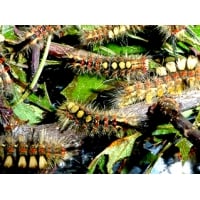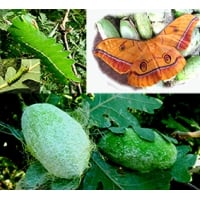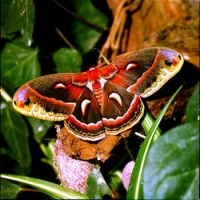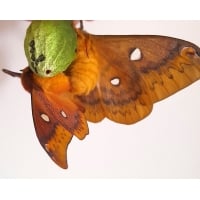Current EGGS and LARVAE
If you are a beginner and need information on rearing from small caterpillars, or hatching out pupae, please order the All Colour Paperback BUTTERFLIES. INSTRUCTIONS ARE NOT SENT WITH EACH SPECIES, you need to acquire basic skills and this book is a simple way of doing so.
Vapourer Moth Orgyia antiqua
Eggs are laid by the wingless female in a batch on the cocoon, where they pass the winter and hatch in spring.
Very interesting both for its moth and its very attractive and colourful caterpillar. Winter eggs are supplied for storage in the cool until spring. The larvae normally hatch in May/June or later, and feed on a wide variety of trees, which include Hawthorn, Willows and Sallows, most fruit trees, Hazel, Rose, Lime and Oak. The larvae are beautifully patterned and coloured, and decorated by prominent shaving brush-like tufts. The cocoon is spun amongst the foodplant.
The male moth is delicate, chestnut brown, with prominent feathered antennae, which are used to detect the wingless female, who emerges from the cocoon and rests on it, calling for a male. She lays her egg batch all over the cocoon where the eggs remain through the winter ready to start off the next generation.
Vapourer Moth Orgyia antiqua
Eggs are laid by the wingless female in a batch on the cocoon, where they pass the winter and hatch in spring.
Very interesting both for its moth and its very attractive and colourful caterpillar. Winter eggs are supplied for storage in the cool until spring. The larvae normally hatch in May/June or later, and feed on a wide variety of trees, which include Hawthorn, Willows and Sallows, most fruit trees, Hazel, Rose, Lime and Oak. The larvae are beautifully patterned and coloured, and decorated by prominent shaving brush-like tufts. The cocoon is spun amongst the foodplant.
The male moth is delicate, chestnut brown, with prominent feathered antennae, which are used to detect the wingless female, who emerges from the cocoon and rests on it, calling for a male. She lays her egg batch all over the cocoon where the eggs remain through the winter ready to start off the next generation.
Giant Atlas Moth Attacus atlas
One of the largest of all moth species in the world! The larvae feed well on Privet, at any time of the year, and might accept Portuguese Laurel. They require very clean conditions, always with fresh food. Alternative recorded foodplants include Willows, Lilac, Apple, Plum, Ash, Cherry and Tree of Heaven Ailanthus. Atlas larvae like to browse on several foodplants and settle for the one or more that they like.
The larvae like warmth 25 -30 degrees C and humid jungle conditions, which are best achieved in a tank or plastic container, rather than a netting cage. Given these conditions the larvae are not difficult to rear, and spin cocoons in about 8 weeks from hatching.
Antheraea yamamai Japan and Central Europe
A rewarding and easy species to rear in spring. The eggs are stored cool for the winter. Bring them into room temperature when the buds open, and the larvae hatch in a couple of weeks or so.
The caterpillar, a close relative of Antheraea pernyi, the Chinese Oak Silkmoth, grows very large. It has a green face and more interestingly, it spins a wonderful egg-shaped cocoon of BRIGHT GREEN silk. Very easy to rear on Oak. The larvae sometime take leaves of other trees and shrubs. Hawthorn is a early substitute for Oak. The pupa is spun in summer and does not emerge until well into autumn. Eggs laid in summer, are dormant through winter; they can be refrigerated, and hatch when the buds open in spring.
The female moth may be a bright canary yellow, with large ringed eye-spots, one in the centre of each wing. Colouring, especially in the male, is rather varied. Both sexes are illustrated with quite different colour forms.
Bullseye Moth Automeris io North America
Eggs and Larvae of the Bullseye Moth are not available every year. This small silkmoth has a number of interesting characteristics.
The male and female are distinctly different colours – both have the enormous eye markings on the hindwings which are exposed when the moth is disturbed.
The larvae are covered by branched spines – don’t touch them – they sting like a nettle! They are gregarious until the larvae are quite large, changing colour at each skin change.
For pairing, keep the moths in a cage the size of the Pyjama Mini Cage. Fertile eggs develop a black dot which is the micropyle, through which the embryo breathes. A useful indicator of fertility, not present in most other species.
The larvae are polyphagous, ie they will accept a wide variety of foodplants, which include such trees as Oak, Lime, Willow, Hazel, Bramble, Apple, Hawthorn and more.
Saturnia jonasii Far East Russia 10 eggs
Keep eggs refrigerated until late March, or when the first buds open.
The last time this species was offered by WWB was over 40 years ago! The young larvae are most decorative. Recorded foodplants include Ornamental Crab Apple Malus, Hawthorn, Sallow, Osier, Sometimes Privet and undoubtedly a number of other trees and shrubs.
Final instar larvae are covered in short bristles and the caterpillar is lime green all over.
The moths emerge in autumn. Their eggs hatch in the following spring.
Rosy Maple Silkmoth (Sycamore Silkmoth) Dryocampa rubicunda North America
This small Silkmoth, highly colourful, is very seldom available. We cannot remember when we last offered eggs and larvae of this species - it was decades ago! The larvae feed on Sycamore and Maples. Gregarious at first, they disperse later in life. Pupation is on the ground amongst leaf litter. The pupae emerge in summer, adults pair relatively easily. A highly attractive species, easily bred and highly recommended. Give this unusual species a try.
Robin Moth Hyalophora cecropia North America
THIS SPECIAL OFFER is because our breeder has had exceptional success and wants to share his stock with more people. The offer may last only a few days so don't miss out!
This is a magnificent species with most decorative larvae that are easy to rear, especially when sleeved. The moth will sit on your finger fanning its wings, like a pet! Highly recommended.
Cecropia is famous and has now become very difficult to obtain. We are pleased to be able to offer eggs again this season. Please take advantage of this opportunity because they may not always be available.
A magnificent and very large moth, coloured with scarlet and charcoal. The larvae are most attractive and easily reared with careful hygiene. They do well sleeved outside in good weather. Osier Willow is the plant that succeeds best for us, and many breeders use Cherry.
Reported foodplants: Lilac, Cherry, Pear, Apple, Plum, Alder, Birch, Dogwood, Willows especially Osier Salix viminalis, Elm, Beech, Gooseberry, Poplar.
Asian Owl Moth Brahmaea tancrei
The larvae are decorated with long, knobbly and curling thoracic spines, which are shed in the final instar. They feed on Privet. The moth is marked with map-like contour lines, with large dark central areas.
Larvae become very active before pupating, they take on a different pre-pupating appearance and wander for some time. At this stage they escape very easily, so ensure the cage is secure. A base of compost or soil is required. The larvae don't burrow, but look for a flat surface under which to settle and pupate.
See the pictures to appreciate the interesting life history.
Highly recommended as a fascinating species to breed!
Squeaking Silkmoth Rhodinia fugax Far East 15 eggs
We are sure that Rhodinia fugax will bring a lot of pleasure to breeders, and happy memories to those who have reared the Squeaking Silkmoth before.
Large larvae squeak when touched or disturbed by noise. Even the pupa squeaks within the extraordinary cocoon, which is green and shaped like a pitcher plant, with an open top. The vessel would fill with water when it rains, but the caterpillar spins a drainage hole in the bottom!
Foodplants include Oak, Sycamore, Maples, Willows and Sallows, Osier, Beech, Hawthorn, and doubtless many other trees and shrubs. Younger larvae change colour at each skin change. Final instar larvae have a clearly defined lateral demarkation between a dark green underside and bright lime green topside, which breaks the recogniseable shape of the caterpillar and helps it to avoid detection by predators.
Moths emerge in autumn. Males are beautifully patterned in chestnut brown. Females are much larger, and patterned in yellow. Eggs laid in autumn remain unhatched until buds open in the spring. Store in a fridge or very cold place, slightly humid, but beware of mould. Don't keep them chilled longer than necessary. You should incubate the eggs as early as food is available in spring. March and April are the best months to incubate.










